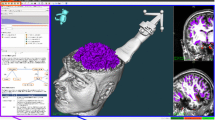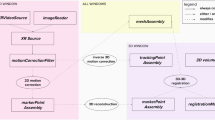Abstract
Objective
The software requirements for computer-aided navigation tools in image-guided therapy become increasingly complex as a result of new imaging and tracking hardware, novel application areas and regulatory restrictions. The objective of this work was to develop a new software framework to meet the needs of emerging image-guided procedures and therapies that require multi-modal imaging and tracking.
Materials and methods
Building on existing open source tools, a software framework was developed to accommodate dynamic data-structures, dynamic input and output interfaces for interventional devices, and dynamic visualization of data. Arbitrary, yet meaningful, connections can be established between these entities in order to implement customized applications that target specific clinical procedures. This framework is called the SIGN.
Results
A series of test applications have been developed, showing the versatility and usability of the image-guided navigation framework.
Conclusion
SIGN addresses new challenges in image-guided therapy related to multi-modal imaging and tracking. The dynamic configurability of SIGN allows for rapid development of new applications.
Similar content being viewed by others
References
Spetzger U, Laborde G and Gilsbach JM (1995). Frameless neuronavigation in modern neurosurgery. Minim Invasive Neurosurg 38(4): 163–166
Arand M (2001). Spinal navigation in cervical fractures–a preliminary clinical study on Judet-osteosynthesis of the axis. Comput Aided Surg 6(3): 170–175
Braticevici B, Onu M and Bengus F (2006). Virtual cystoscopy: a surgical planning and guidance tool. Arch Ital Urol Androl 78(1): 23–24
Cheng P (2006). IGSTK: Framework and example application using an open source toolkit for image-guided surgery applications. Proceedings of the SPIE 641: 590–598
Slicer 3. http://www.slicer.org
Burgielski Z (2002). Julius: a software framework for computer-aided-surgery. Biomed Tech (Berl) 47 Suppl 1 Pt 1: 101–103
CISST. http://www.cisst.org/cisst
Simon DA (1997) Intra-operative position sensing and tracking devices. In: First Joint CVRMed / MRCAS Conference
Jalote-Parmar A et al (2006) Exploring a user centric methodology to investigate and integrate information gathered during medical intervention. In: 16th world congress on ergonomics Elsevier, Maaastricht
Lemke HU (2005). Workflow in the operating room. Biomed Tech (Berl) 50(5): 153
Aalst WMPvd and Hofstede AHMt (2005). YAWL: Yet another workflow language. Inf Syst 30(4): 245–275
Spiczak Jv et al (2007) Device connectivity for image-guided medical applications. In: Medicine Meets Virtual Reality, vol 15. IOS, Long Beach
DiMaio S et al (2007) Dynamic MRI scan plane control for passive tracking of instruments and devices. In: 10th international conference on medical image computing and computer assited intervention. Springer, Brisbane
Samset E, DiMaio SP (2007) Hybrid tracking: a new trend in image-guided therapy. In: IEEE VR 2007 workshop on trends and issues in tracking for virtual environments, Charlotte, NC, USA. Shaker, Aachen
Cleary K (2005). Electromagnetic tracking for image-guided abdominal procedures: overall system and technical issues. IEEE Eng Med Soc 7: 6248–6753
Moghari MH and Abolmaesumi P (2005). A novel incremental technique for ultrasound to CT bone surface registration using unscented Kalman filtering. Med Image Comput Comput Assist Interv Int Conf Med Image Comput Comput Assist Interv 8(Pt 2): 197–204
Wada J et al (2005) Development of a navigation system for neurofiberscopic surgery. In: Symposium of the international brain mapping and intraoperative surgical planning society
Samset E et al (2006) ECG triggered MRI-guided navigation for cardiac interventions. In: Proc ISMRM, Seattle, USA
Hans A, Ellis R and Samset E (2007). Out-of-plane CT Guidance for needle placement using and open source navigation framework. Computer aided radiology and sugery. Springer, Berlin
Author information
Authors and Affiliations
Corresponding author
Rights and permissions
About this article
Cite this article
Samset, E., Hans, A., DiMaio, S. et al. A dynamic and extensible workflow-oriented software framework for image-guided therapy. Int J CARS 2, 221–229 (2007). https://doi.org/10.1007/s11548-007-0131-3
Received:
Accepted:
Published:
Issue Date:
DOI: https://doi.org/10.1007/s11548-007-0131-3




